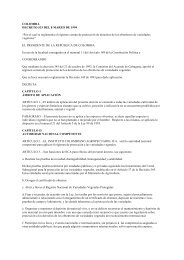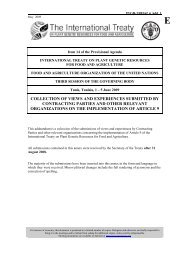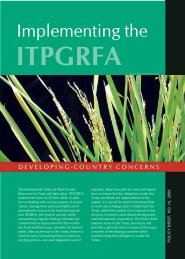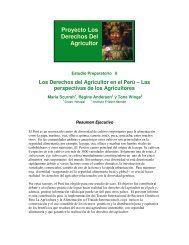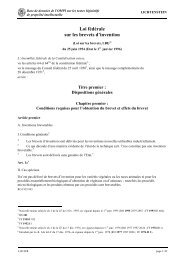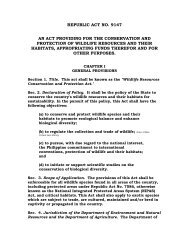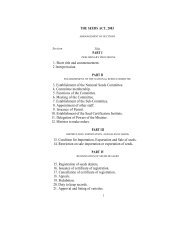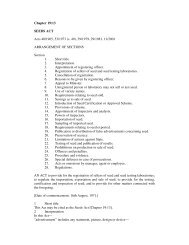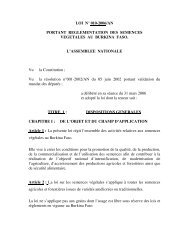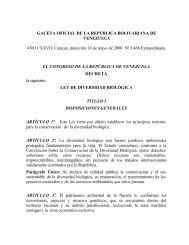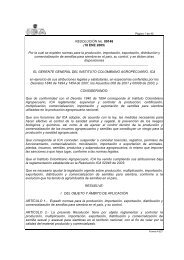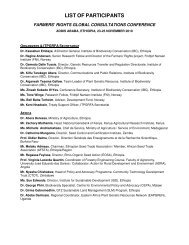Para PDF Tesis con Figuras en Word.p65 - Farmers' Rights website
Para PDF Tesis con Figuras en Word.p65 - Farmers' Rights website
Para PDF Tesis con Figuras en Word.p65 - Farmers' Rights website
Create successful ePaper yourself
Turn your PDF publications into a flip-book with our unique Google optimized e-Paper software.
the coeffici<strong>en</strong>t limit (table 2.8). Morphotypes are accessions belonging to a cluster at < 25%<br />
dissimilarity; these are repres<strong>en</strong>ted in the d<strong>en</strong>drogram by a dissimilarity coeffici<strong>en</strong>t higher or<br />
equal to the coeffici<strong>en</strong>t limit. Pure duplicates are accessions with one or more equal pairs at a<br />
coeffici<strong>en</strong>t of 1.00 (100% similarity).<br />
Table 2.8: Results of a dissimilarity analysis using the Jaccard coeffici<strong>en</strong>t and UPGMA<br />
clustering method applying NTSYS-pc 2.1 software and <strong>con</strong>sequ<strong>en</strong>t id<strong>en</strong>tification of<br />
unique cultivars, morphotypes, and pure duplicates by population<br />
Population Accessions Coeff. Coeff. Unique Morphotypes Pure<br />
(n) range limit cultivars duplicates<br />
Total 989 0.25-1.00 0.81 406 547 36<br />
P1 634 0.25-1.00 0.81 250 362 22<br />
P2 298 0.29-1.00 0.82 195 97 6<br />
ISC-01 175 0.26-1.00 0.82 96 71 8<br />
ISC-02 160 0.29-1.00 0.82 120 39 1<br />
ISC-03 138 0.27-1.00 0.82 90 46 2<br />
ISC-04 161 0.24-1.00 0.81 84 70 7<br />
ISC-05 170 0.33-1.00 0.83 117 49 4<br />
ISC-06 58 0.35-1.00 0.84 52 6 0<br />
ISC-07 70 0.28-1.00 0.82 60 9 1<br />
ISC-08 57 0.25-1.00 0.81 49 8 0<br />
Analysis based on SSR marker data g<strong>en</strong>erally provided a more rigid means of classification,<br />
recognizing lower total numbers of unique cultivars, compared with analysis based on<br />
morphological descriptor data for the same farmer family subpopulations (ISC-01 to ISC-08).<br />
The total size of molecularly distinct cultivar pools ranged betwe<strong>en</strong> 49 and 120 unique cultivars<br />
for sampled and analyzed farmer family subpopulations. This result reaffirms that households in<br />
Huancavelica maintain high levels of cultivar diversity within their potato crop.<br />
The two geographically distanced subpopulations <strong>con</strong>tain 250 (P1) and 195 (P2) unique<br />
cultivars. The differ<strong>en</strong>ce of 55 unique cultivars may in part be a <strong>con</strong>sequ<strong>en</strong>ce of the initial number<br />
of accessions <strong>con</strong>sidered: 624 (P1) versus 298 (P2). Still, the total size of both cultivar pools,<br />
geographically distanced by approximately 90 kilometers, is appreciable and suggests that both<br />
areas can be <strong>con</strong>sidered as diversity “hotspots” for the cultivated potato.<br />
Considerable molecular diversity also exists within the overall regional population (fig. 2.3).<br />
Most accessions were molecularly distinct with only 36 pure duplicates <strong>en</strong>countered within the<br />
total population <strong>con</strong>sisting of 989 accessions. A total of 406 molecularly distinct and unique<br />
cultivars, belonging to clusters showing more than 25% dissimilarity, were id<strong>en</strong>tified. No species<br />
specific clusters were observed.<br />
50 Potato diversity at height: Multiple dim<strong>en</strong>sions of farmer-driv<strong>en</strong> in-situ <strong>con</strong>servation in the Andes



